
Akiko Kinugawa, Sachi Hasegawa
Latencies
2022.10.29 (Sat) - 2022.12.3 (Sat)
Open on Tue., Wed., Thu., Fri. and Sat., 12:00 – 18:00
Closed on Sunday, Monday, and holidays
Reception for the artist: 10.29 (Sat.), 17:00 – 19:00
Talk event: 11.12 (Sat.), 17:00 – 18:30
Speakers: Akiko Kinugawa, Sachi Hasegawa, Arata Hasegawa (independent curator)
For more information on the event, click here.
*Language:Japanese
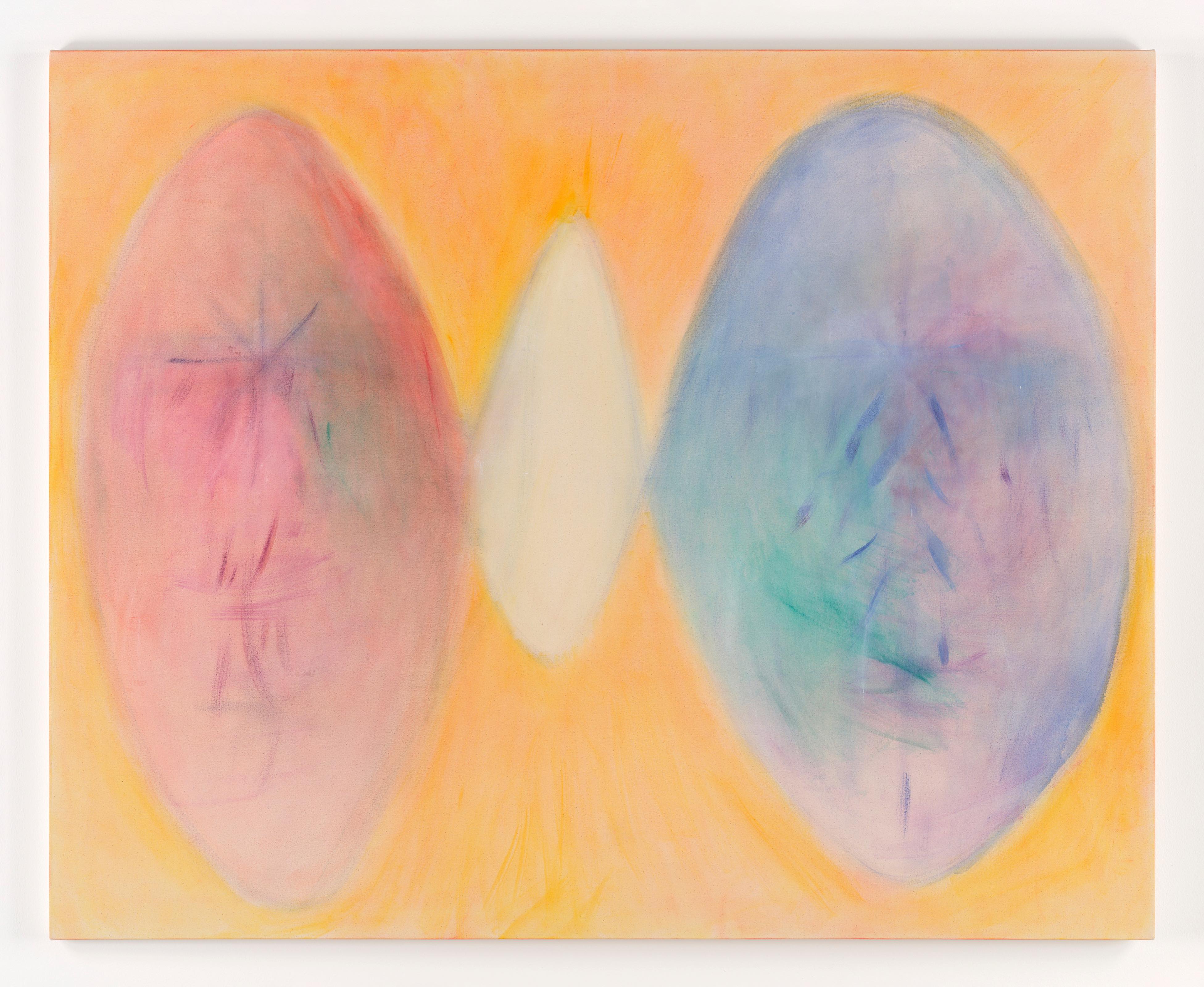 Akiko Kinugawa “right and left” 2022, Oil on canvas, H130.4xW162cm ©︎Akiko Kinugawa
Akiko Kinugawa “right and left” 2022, Oil on canvas, H130.4xW162cm ©︎Akiko Kinugawa
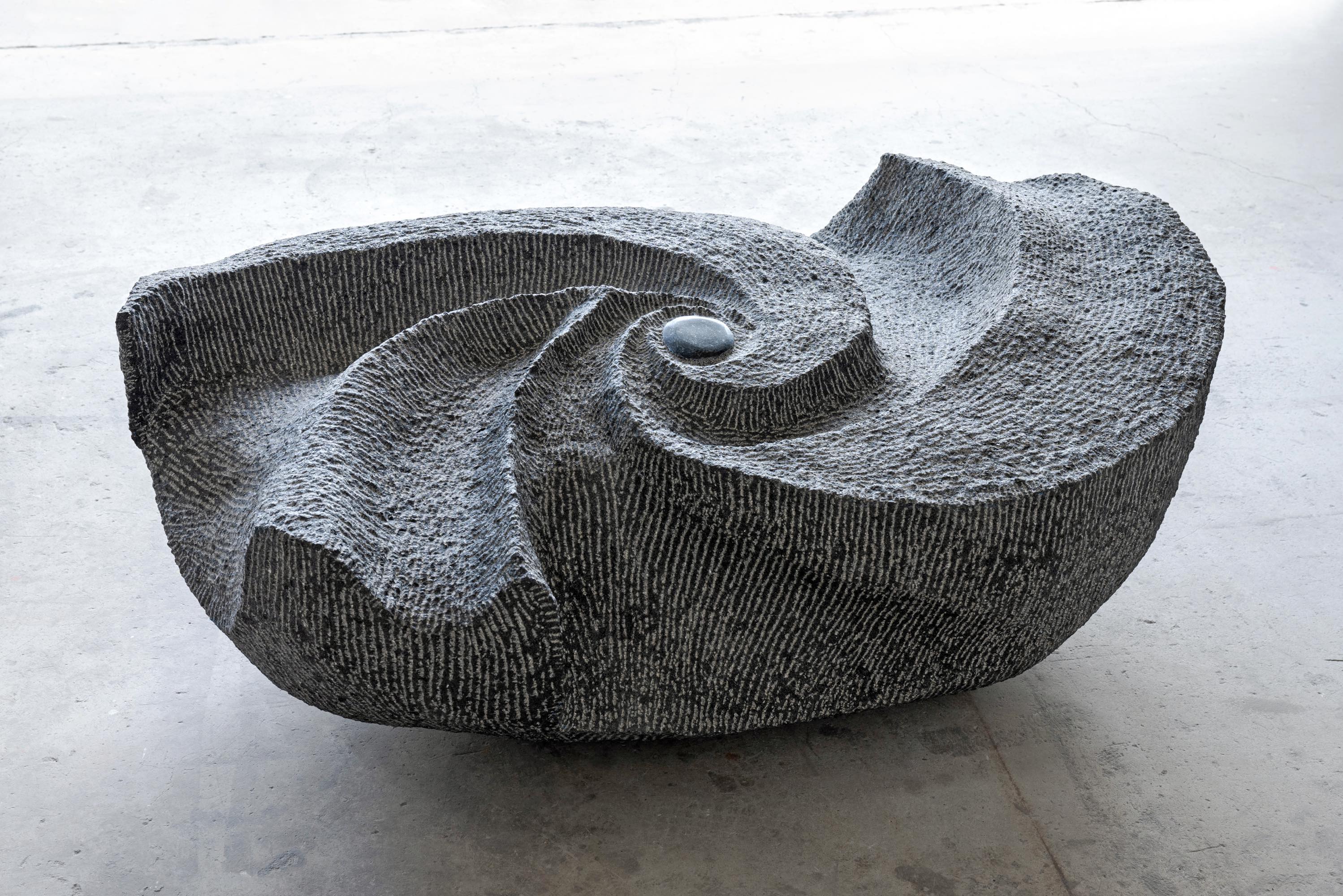 Sachi Hasegawa “Interspace” 2022, Black granite, H50xW125xD74cm ©︎Sachi Hasegawa
Sachi Hasegawa “Interspace” 2022, Black granite, H50xW125xD74cm ©︎Sachi Hasegawa
We are pleased to inform you that ANOMALY will be holding a two-person exhibition by Akiko Kinugawa and Sachi Hasegawa titled Latencies, from October 29 (Sat.) to December 3 (Sat.), 2022.
“The flow of the river is ceaseless and its water is never the same. The bubbles that float in the pools, now vanishing, now forming, are not of long duration.”
– From An Account of My Hut by Kamo no Chomei, translated by Donald Keene
Born in New York in 1986, Akiko Kinugawa has a keen sense of the boundaries between the self and others, and between body and land/landscape. Through her technique of applying thin layer after layer of oil paints as if smearing them on the canvas, she produces smudged images of life that seem to float up vaguely and keep slowly changing.
Born in Hyogo Prefecture in 1982, Sachi Hasegawa makes sculptured works that are covered all over with the fine marks left by her chiseling. Rendering the subtle vibrations of matter visible, they seem to resonate with the space and the consciousness of those viewing them.
This exhibition will display paintings by Kinugawa and sculptured works by Hasegawa, including newly created ones.
Akiko Kinugawa aspires to come face to face with the realm that she believes lies behind the words/meanings given to forms we apprehend by vision and that all living beings making up the world have in common. To this end, she first repeatedly created paintings in which people, dogs, cats, and hybrids of human beings and animals peered out from the canvas at the viewer. As she continued with the production of such works, she began to feel that the faces she painted were consciousness (non-material), and the pigments and canvas, body (matter). Meanwhile, the subject faces and bodies dissolved and became amorphous. Along with this change, flowing particles and light-emitting colors started to appear.

Akiko Kinugawa “align” 2022, Oil on canvas, H145.5xW112.2cm ©︎Akiko Kinugawa
In 2018, Kinugawa began to employ a new method of painting she devised for a more multifaceted pursuit of this interest, which she terms “depict while listening.” For works in the related series, which she periodically produces even at present, she asks models to direct their consciousness inside their bodies, and makes charcoal drawings of them while asking them in what part of the body they feel emotion and listening to their replies. The raw words/voices born of the complexly intertwined relationship between body and emotion soften the focus of our vision that stops on the outside of the body, blur the boundary with “the other,” and continue to make Kinugawa’s grasp of body highly thought-provoking.
As Kinugawa’s sense of her own body and those of others became both more acute and flexible, her boundaries with the periphery of individuals and land/landscape became vaguer. In the process, she was drawn to images that, while primitive, deviate from entrenched concepts, such as the way topographical formations far beyond the physical scale of the human body are likened to it, or parts of it. Examples are local claims to being “Japan’s navel” and the characterization of certain mountains as female or male bodies. This has led her to make paintings that project and superimpose the human body and organs inside it on natural features such as mountains and rivers in recent years.
Around 2019, Kinugawa began researching Japanese myths and legends describing things such as the creation of human beings from earth, the formation of islands by stirring chaos, the metamorphosis of human beings into other creatures, and changes of sex. She actually makes trips to places where nature worship still remains, and reflects what she sees and hears there in her motifs.
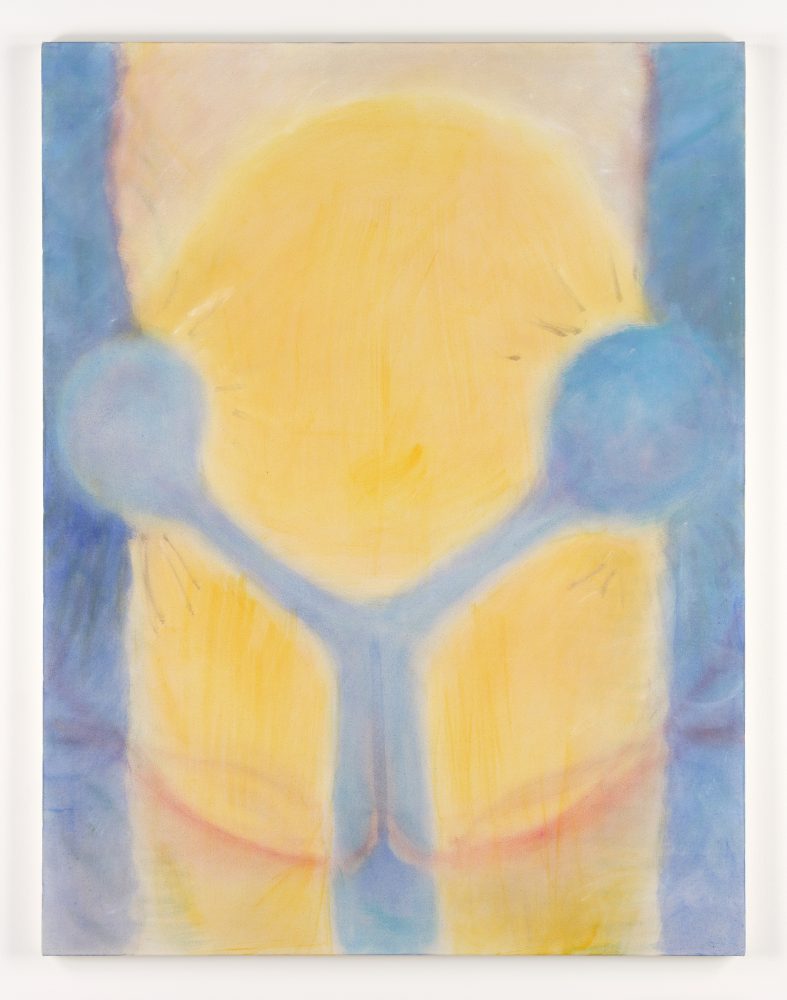
Akiko Kinugawa “two” 2022, Oil on canvas, H145.5xW112.2cm ©︎Akiko Kinugawa
When smearing layers of color on the canvas, I feel as if I can see particles of color moving in a vibration-like manner, and hear sounds that could not be heard by the human ear.
I look into the nature of that vibration.
The directions of colors, the emotions of different colors.
Colors and sounds do not have any meaning, but even if they are loosely given a form, their tone flows on as before.
– Akiko Kinugawa
Sachi Hasegawa has been striving to make visual representations, in stone, of phenomena and memories that cannot be grasped by the eye, such as the circle of life and vibrations made by matter, while referencing landscapes that were presumably seen by our distant ancestors and natural phenomena that have been objects of awe. In recent years, she has been incorporating glass into her works and exploring boundaries between matter and space.
Countless fine marks made by her chisel cover the surface of stone formed over eons, quietly shake the space and mind of the viewer, and leave the impression that the stone’s mass and time are scattering and melting into the space. The moment they are placed in the exhibition area, Hasegawa’s sculptures become devices for its conversion into a different dimension, and have the potential to transform its space at a single stroke.
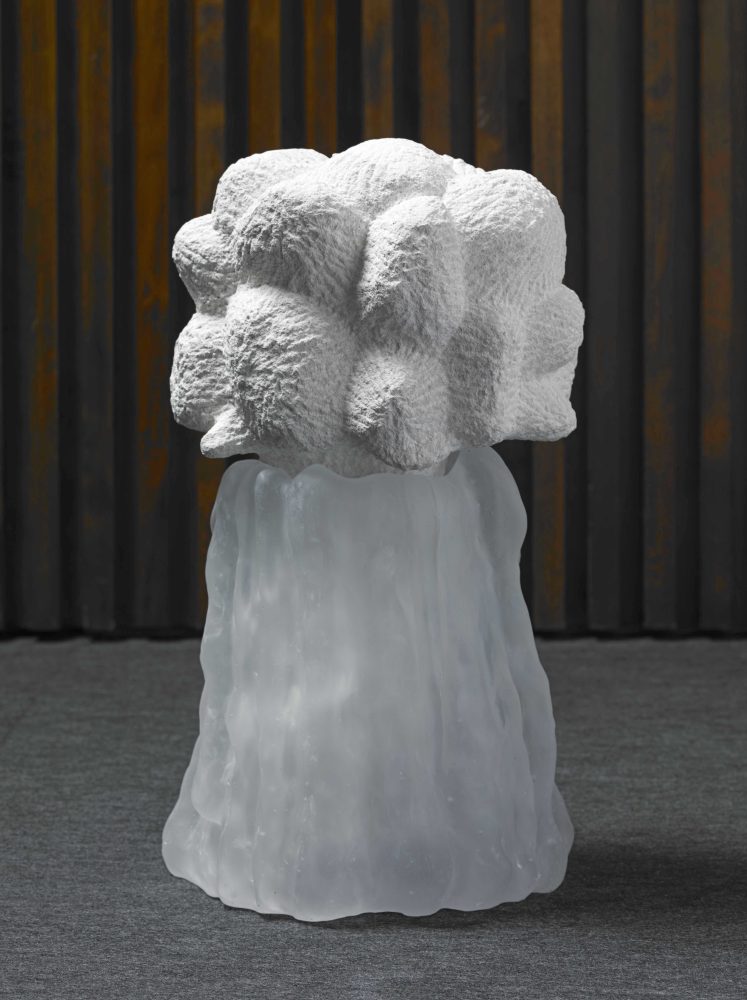
Sachi Hasegawa “wood” 2018, Limestone, glass, H50xW27xD26cm ©︎Sachi Hasegawa
In Awai (2022), one of her newest works, there appear spiral-like designs. These recall the spiral patterns that are associated with the Celtic, Jomon, Ainu, and other cultures in many parts of the world, and are imbued with a reverence for nature and prayerful sentiment. The energy of a spiral, which continues to become enlarged and amplified, seems to cross the boundary between matter and space, and to expand without limit.
¹⁾“The natural world is full of spiral designs: shells, coiling snakes, butterfly proboscises, plant tendrils, water currents, sea tides, air currents, and whirling typhoons. Even the very Milky Way galaxy we inhabit forms a huge swirl.
We see spiral patterns on many human cultural heritage sites. This is undoubtedly because, in the course of human history, they inspired wonder, interest, and awe in the minds of many generations of our ancestors.
The spiral is perhaps the ultimate design symbolizing the cyclic nature of life and nature.
Viewing spirals in this light, we cannot help but become aware that we are existences which revert from linearity to non-linearity, and go back into the flux.”
In places that appear to contain nothing at all at first glance, there are moments when, if I stare intently, I think I can see tiny drifting particles of energy coming together and converted into some sort of object. I feel a similarity with the sensation that the boundary line with reality is dissolving as I sculpt stone, and the oscillation between matter and consciousness.
Waves emitted from pictures are converted into sculptures and revert to pictures in a cyclic flow…I am hoping for the birth of this kind of space in this exhibition.
– Sachi Hasegawa
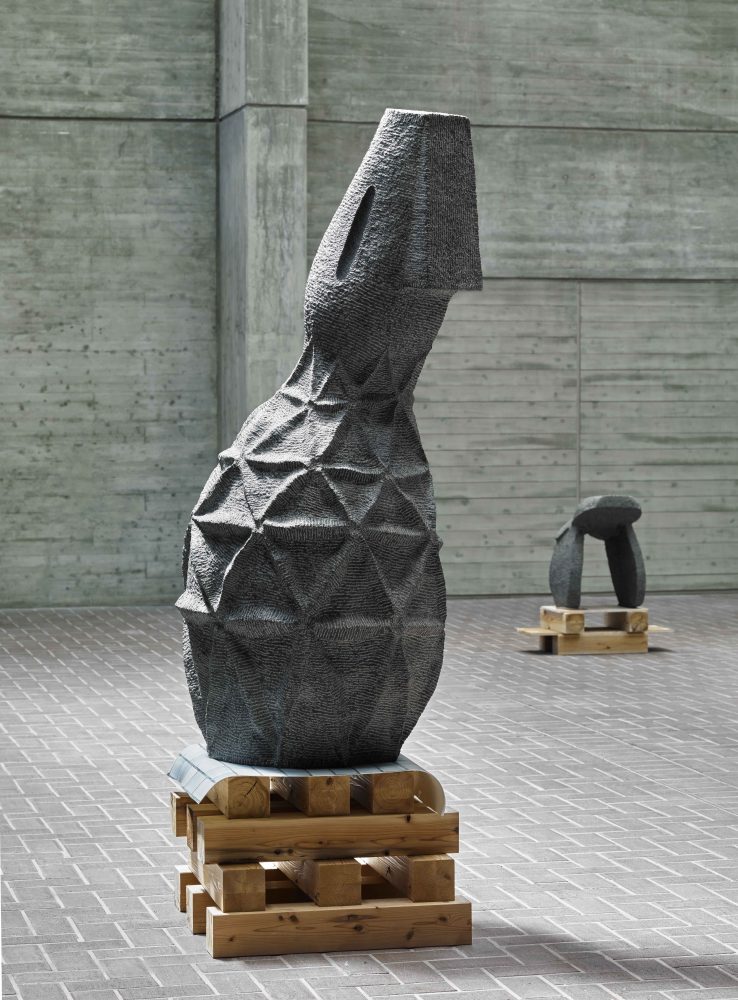
Sachi Hasegawa “nebula” 2021, Black granite, H163xW58xD70cm ©︎Sachi Hasegawa Pedestal: Hiroshi Sugito
“Omni-Sculptures-The Scene of Emergence” Installation view, Musashino Art University Museum, Tokyo, Japan, 2021 Photo by Tadasu Yamamoto
²⁾“We have the sensation that our bodies have substance as individual entities separated from the world outside them. On the molecular level, however, there is absolutely no assurance for this feeling. We living organisms are nothing more than loose pools of molecules whose density happens to be higher at that location. Moreover, these molecules are being replaced at a high speed.”
All living organisms making up our world are in constant and continuous motion and change. Both Kinugawa and Hasegawa are intently looking at and listening to a realm and phenomena that cannot be perceived by the human senses of sight and hearing, and their works consequently echo each other. At this exhibition, you can definitely look forward to experiencing display space charged with a synergy that could only be generated by these two artists.
We have also scheduled a talk event with independent curator Arata Hasegawa on November 12 (Sat.). Once the details have been finalized, we shall provide information on this event on ArtSticker, the Anomaly website and SNS account.
It should be added that Kinugawa will be residing in Hawaii for a period of one year beginning in 2023 as a trainee under the Program of Overseas Study for Upcoming Artists conducted by the Agency for Cultural Affairs, and that Hasegawa is currently participating in Flower of Life, an exhibition now being held at the Vangi Sculpture Garden Museum to celebrate its 20th anniversary.
Op. cit.
¹⁾ Shinichi Fukuoka, “Seimei wa bunshi no ‘yodomi’” (Life is “pools” of molecules), in Shinpan doteki heiko: Seimei wa naze soko ni yadoru no ka (Dynamic equilibrium (new edition): Why does life abide there?), Shogakukan Shinsho, 2017, p. 282
²⁾ Shinichi Fukuoka, “Doteki heiko to wa nani ka” (What is dynamic equilibrium?), in Seibutsu to museibutsu no aida (Between the animate and inanimate), Kodansha Gendai Shinsho, 2007, p. 163
*Quotations are tentative translations of excerpts from the Japanese translations.
Bibliography
– Henri Bergson, L’Énergie spirituelle (Mind-energy; the Japanese translation published by Heibonsha in 2012)
– Henri Bergson, La Pensée et le mouvant (Thought and Movement; the Japanese translation published by Heibonsha in 2013)
– Yoshiaki Ikeda & Shinichi Fukuoka, Fukuoka Shinichi, Nishida tetsugaku wo yomu: Seimei wo meguru shisaku no tabi (Shinichi Fukuoka reads Nishida’s philosophy: A journey of thought concerning life), Shogaku Shinsho, 2020
– project N 83: Akiko Kinugawa, Tokyo Opera City Art Gallery, 2021
Akiko Kinugawa
Akiko Kinugawa was born in New York in 1986 and currently resides in Tokyo. She received an MFA degree in oil painting from Musashino Art University Graduate School in 2012. She believes that a realm of unlimited equality spreads out behind all living beings composing the world. Through her technique of applying thin layer after layer of oil paints as if smearing them on the canvas, she produces smudged images of life that seem to float up vaguely and keep slowly changing. Her main exhibitions include Crazy for Painting – vol. 6: Akiko KINUGAWA, (2012, gallery αM, Tokyo), VOCA: Vision of Contemporary Art, 2015 (2015, Ueno Royal Museum, Tokyo), Unusualness Makes Sense – Alternative Art Practices by Thai and Japanese Artists (2016, Chiang Mai University Art Center, Chiang Mai, Thailand), and project N 83: Akiko Kinugawa (2021, Tokyo Opera City Art Gallery, 4F corridor, Tokyo).
Sachi Hasegawa
Sachi Hasegawa was born in Hyogo Prefecture in 1982 and currently resides in Tokyo. She received an MFA degree in sculpture from Musashino Art University Graduate School in 2006. She produces sculptured works that make visible phenomena and memories that cannot be seen with the eye, such as subtle vibrations of matter and the feeling of human presence. Since 2008, she has been holding solo exhibitions at venues including hino gallery and switch point. Her main solo exhibition was Ley Line: Sculpture by Sachi HASEGAWA (2017, Hiratsuka Museum of Art, Kanagawa). Her main group exhibitions include Delineate Space – Sculpture and Dessin, (2019, Hiratsuka Museum of Art, Kanagawa), Looking for the 4th Dimension: Dali etc. and 21st Century Dialogue (2019, Morohashi Museum of Modern Art, Fukushima), Omni-Sculptures: The Site of Emergence (2019, Musashino Art University Museum, Tokyo), DENCHU Strut – Connected Sculpture (2021, Kodaira Hirakushi Denchu Art Museum, Tokyo), Everybody Needs a Rock (2021, Vangi Sculpture Garden Museum, Shizuoka), and 20th Anniversary Exhibition: Flower of Life (2022, Vangi Sculpture Garden Museum, Shizuoka).
Notification of precautions and requests
To prevent the spread of COVID-19, and to ensure the safety of visitors, artists, staff, and the community in compliance with the government’s health guidelines, please take a moment for the following requests upon your visit.
Visitors are asked to wear masks and sanitize hands before entering the gallery. Hand sanitizer is available at the entrance.
Please refrain from visiting the gallery if you have symptoms such as a fever (37.5°C or higher) or cough.
Our staff will have temperatures taken before coming to work to check health conditions every day, and will guide you by adopting frequent hand hygiene and wearing masks.
The entire space will be regularly ventilated and we will disinfect the high-touch areas.
Please check our website or SNS for the latest information about opening hours, as we may change it or close the gallery in unpredictable circumstances.
We appreciate your cooperation.









